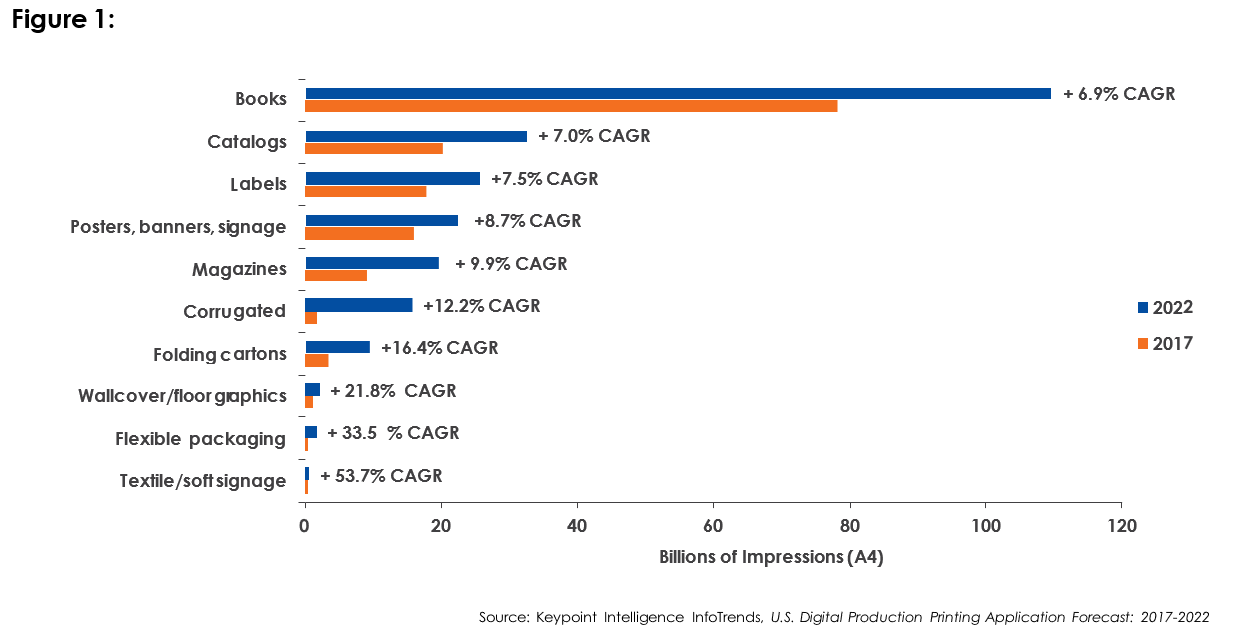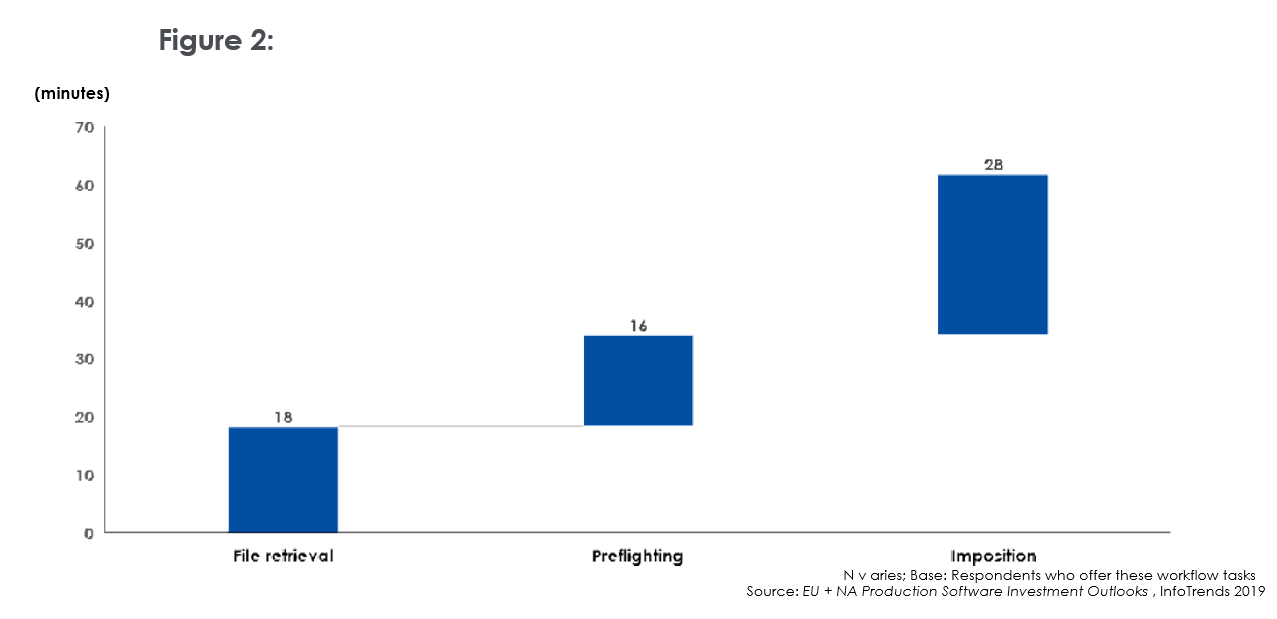
Welcome to this HP Site Flow whitepaper on publishing on-demand. This is part of a series of whitepapers commissioned by HP in 2020 and provides a thorough independent analysis of current workflow trends and the benefits that it can bring across verticals. From capturing digital labels and packaging through short- runs and mass customisation to scaling to thousands of orders without falling apart, this series is designed to help any print service provider get the full picture. The whitepapers can be read in full on this site or downloaded instantly as a PDF with no pesky forms to fill out. From all of us in the HP Site Flow team, we hope you find the series useful.
Keypoint Intelligence White Paper: A BOOK OF ONE…PROFITABLY
- Keypoint Intelligence White Paper: A BOOK OF ONE…PROFITABLY
- Introduction
- Books are High Growth Application in Digital
- The 10 Fastest Growing Production Digital Print Applications (by Growth Rate)
- Publishers are Adapting
- Gaining Value from New Opportunities
- A Profitable Book of One Requires a Super-efficient Workflow
- Average Operator Time per Job for Repetitive Workflow Tasks
- HP Site Flow – the Platform for Digitally Printed Books
Introduction
Books and other bound documents represent one of the biggest and fastest growing opportunities in the production digital print marketplace. These applications benefit from some of the core values of a digital print workflow:
-
Commercially viable short print runs
-
Print-on-demand based on actual book sales instead of forecasted demand
-
A just-in-time workflow that eliminates the need for warehousing and opens up revenue opportunities for publishers’ back lists
-
Book of one production in photobooks, personalised books, and self-publishing
-
Variable data printing that gives content creators and print service providers (PSPs) new abilities to generate personalised documents while automating production
These are just some of the reasons driving growth in digitally printed books, despite strong competition from e-books and long-run offset. Automated end-to-end workflows are key in allowing PSPs to benefit from this growth.
Books are High Growth Application in Digital
Keypoint Intelligence’s US Digital Production Printing Application Forecast puts books among the top ten growth-oriented production digital print applications in the United States. Not only are books among the fastest growing digital print applications, they are also one of the largest production digital print applications. At a 6.9% compound annual growth rate (CAGR), book volume will exceed 100 billion A4/letter sized impressions by 2022.
6.9% Forecasted 2017-2022 growth rate of digitally printed books
The 10 Fastest Growing Production Digital Print Applications (by Growth Rate)

Toner-based printers and copiers have laid the groundwork for this sizable market and, more recently, inkjet-based systems are expanding the growth due to their high level of productivity. This opens new opportunities in book and bound document production.
In addition, traditional publishing market statistics reveal that sales of printed books are showing consistent year-over-year growth. The market for printed books grew 1.3% from 2017 to 2018. This growth (though not huge) comes in the face of significant competition from electronic media, specifically e-books. In addition, more recent statistics show that there was a 5% month-to-month increase in US print book sales from January 2019 to January 2020.
Not long ago there were dire predictions about the death of the printed book. That has not happened. While e-books play an important role, readers are making it clear that they still like printed books. e-Books are a $1 billion market in the United States; while that is significant, e-book revenues have been steadily declining over recent years. Printed books have not been replaced by e-books.
Publishers are Adapting
Content producers are adapting and recognising the revenue opportunity that exists in their backlists (i.e., books they have already published). PSPs can help publishers drive revenue from their backlists through publishing on-demand and just-in-time book manufacturing methods, but it goes beyond that. Traditional publishers are not the only source of book content today. The expansion of desktop publishing and digital photography combined with e-commerce websites and digital production printing technology have created entire new markets—many of which reject old-fashioned print- and-inventory book models and, instead, embrace collaborative book-of-one production models including:
-
Photobooks: The meteoric rise in image quality and pixel resolution of digital cameras means that most people can take high quality photos, which can then be repurposed for photobooks and all sorts of photo merchandise that is typically fulfilled as individual orders or very short runs.
-
Personalised books: Remember how it used to be a big deal for a child to receive a personalised book in which their name was inserted as the main character? These kinds of books have existed for years, but have now taken off because of book-of-one business models.
o Not only does the child (or the entire family including pets) appear in the book, but the illustrated characters look like them and share their likes and dislikes.
o Children’s books are where the largest amount of personalised book activity is happening today, but the opportunity is expanding into other categories like celebrations (e.g., birthdays, graduations, engagements, weddings, anniversaries); vintage-inspired gift books that reflect the recipient’s year of birth; end-of-life photobooks (for funerals and memorial services); school yearbooks; promotions for customers, employees, or alumni; and prestige or award events.
- Self-published books: A wide of range of options are open today to budding novelists, amateur historians, memoirists, and others who wish to publish a book. These sites can also help with editorial, design, proofing (a perfect book-of-one service), and even marketing if desired. A self-publisher using one of these services can upload a PDF and a cover and start selling books with no inventory, and without having to worry about printing, packing, and shipping the books. These are all models that simply did not exist (or only existed in rudimentary fashion) for decades. Now that these models have taken hold, PSPs must adapt to the reality of the shorter run lengths and increased numbers of jobs that these models require. Many of you will have already considered partnering with one of the branded photobook, personalised book, or self-publishing companies. The simple reality of this is that they all require highly automated, end-to-end workflows for you to serve as the back-end print and fulfilment provider. Production digital printing technology is vital in this equation, but it must be adequately supported by workflow and finishing.
Gaining Value from New Opportunities
PSPs can help publishers and other content creators gain value from new and existing assets through automated on-demand print, just-in-time manufacturing, and one-off production of books and other bound documents like annual reports, catalogues, directories, magazines, photo albums, training materials, and user manuals. To produce short-runs and small batches, a PSP needs to optimise all the functions that support book production, including job onboarding, preflighting, queuing, finishing, support for e-commerce transaction, shipping, and status updates provided automatically to their brand and publishing customers. These capabilities are indispensable in a highly automated book production environment. Handling short-run binding is a potential barrier because of the wide range of formats and binding types. For this reason, many PSPs will guide customers to a focused set of substrates, trim sizes, and finishing methods.
Throughout this process, it is important to promote the value of digital print production. It allows content creators to stock inventory as needed, to sell only when orders are in house, and to produce out-of-print content in a short-run, on-demand fashion. Traditional offset, while remaining the acknowledged leader in long-run printing, does not excel in the short- run, quick turnaround, on-demand workflows that define production digital print. Book-of-one production takes the concepts of on-demand printing and just-in-time manufacturing to the next level and must be addressed by PSPs with publishing customers.
A Profitable Book of One Requires a Super-efficient Workflow
True print-on-demand becomes a reality once workflows are in place that consolidate volume and automate production. HP Site Flow is an end-to-end workflow automation and production management solution. It enables automation of features such as job submission, prepress (including preflighting, batching, imposition, scheduling, and barcoding), shop floor management, print production, finishing and assembly, creation of shipping labels, automated status notifications, and reprinting. These capabilities are central to creating a highly automated production environment for books and other bound documents.
The issue for many PSPs is that job volumes are rising to an unprecedented level, putting added pressure on production staff. A 2019 Keypoint Intelligence study of European and North American print service providers offering publishing services showed that the average number of jobs produced in a month was 1,629. That is nearly 20 jobs per shift (assuming 24/7 production). The average number among all printer types is even higher at 1,987 jobs per month. It is fair to assume that, as book-of-one workflows gain hold, the average number of jobs per month in publishing environments will rise dramatically. The responses to this survey also show that some print service providers (those at the high end of the jobs per month scale) are producing as many as 3,000 or more per month. How do they accomplish this? It comes down to an automated end-to-end workflow that encompasses order taking, production, and shipping.
In the same survey, Keypoint Intelligence asked respondents about the average time it takes to complete three repetitive workflow tasks: file retrieval, preflighting, and imposition. Respondents reported a combined time of more than an hour to handle these tasks. Clearly, this represents an automation opportunity that has huge implications regarding staff productivity levels.
1,629 Average number of jobs per month produced by PSPs offering publishing services
How much time can workflow automation save you? That depends on the types of applications you produce and the status of your workflow automation. Do these times for repetitive workflow tasks mirror what is going on in your shop?
Average Operator Time per Job for Repetitive Workflow Tasks

Even with book-of-one production, automating three time- consuming tasks could save over 60 minutes and €37 per job.
HP Site Flow can reduce the time for these workflow steps dramatically. This speeds the process, frees staff for productive tasks, and saves you money. How much? Keypoint Intelligence’s data combined with HP’s field experience with HP Site Flow indicates that, in a publishing environment, HP Site Flow can eliminate the 62 minutes required for these tasks through end-to-end automation. The time-saving impact is remarkable and (assuming an operator making €45 per hour) there is a significant cost savings benefit of more than €37 per job. Using the average job figure of 1,629 per month from the research, this could lead to cost savings of more than €700,000 annually (not to mention the positive impact on productivity and profitability).
€700K Potential annual cost savings from the implementation of an automated workflow
HP Site Flow – the Platform for Digitally Printed Books
HP Site Flow has the range of required features to enable efficient and profitable production of books and other bound documents from creation through to fulfilment. This offers PSPs growth opportunities through a truly automated end-to-end workflow that shrinks the time for repetitive tasks and removes time-consuming manual steps, saving them hours of operator time that have a direct impact on the bottom line—up to €37 per job. With book-of-one applications trending up for publishing on-demand, publishing printers will need to adapt to larger numbers of jobs while retaining and improving profitability. HP Site Flow can give them that edge.
